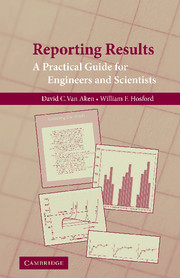Book contents
- Frontmatter
- Contents
- Preface
- REPORTING RESULTS
- 1 Elements of Technical Writing
- 2 Technical Papers
- 3 Technical Letters
- 4 Oral Presentations
- 5 Presentation of Technical Data
- 6 Statistical Analysis of Experimental Data
- 7 Resumé Writing
- Appendix I COMMON ERRORS IN WRITING
- Appendix II PUNCTUATION
- Appendix III COMMON WORD ERRORS
- Appendix IV INTERNATIONAL SYSTEM OF PREFIXES AND UNITS
- Appendix V THE GREEK ALPHABET AND TYPICAL USES
- Appendix VI STRAIGHT-LINE PLOTS FOR SOME MATHEMATICAL FUNCTIONS
- References
- Index
4 - Oral Presentations
Published online by Cambridge University Press: 05 September 2012
- Frontmatter
- Contents
- Preface
- REPORTING RESULTS
- 1 Elements of Technical Writing
- 2 Technical Papers
- 3 Technical Letters
- 4 Oral Presentations
- 5 Presentation of Technical Data
- 6 Statistical Analysis of Experimental Data
- 7 Resumé Writing
- Appendix I COMMON ERRORS IN WRITING
- Appendix II PUNCTUATION
- Appendix III COMMON WORD ERRORS
- Appendix IV INTERNATIONAL SYSTEM OF PREFIXES AND UNITS
- Appendix V THE GREEK ALPHABET AND TYPICAL USES
- Appendix VI STRAIGHT-LINE PLOTS FOR SOME MATHEMATICAL FUNCTIONS
- References
- Index
Summary
At some point in the career of every scientist and engineer, they will be asked to present their findings to an audience of peers or a group of investors. In both cases, the purpose of the presentation is to sell ideas to the audience. Effective presentations maintain the attention of the audience. This chapter provides some basic guidelines for preparing an effective oral presentation.
Assessing the Audience
In planning an oral presentation, it is important to consider the knowledge level of the audience. Usually there is a wide discrepancy between backgrounds of different people. A talk should begin by telling the audience something they already know and then gradually work up to new material. A speaker should not try to impress the audience with his or her knowledge, since that will turn off most listeners. It is better to give a general talk that 95 percent of the audience can understand than an in-depth talk that only one or two people can comprehend. The number of equations in the presentation should be limited. Most audiences cannot digest more than three equations. Trying to cover too much material in the allotted time is a common mistake. A presentation should be pared down to one main theme.
Organization
Presentations must be carefully planned and organized to finish in time so that the audience can ask questions. Using too little time is preferable to using too much time.
- Type
- Chapter
- Information
- Reporting ResultsA Practical Guide for Engineers and Scientists, pp. 41 - 52Publisher: Cambridge University PressPrint publication year: 2008



